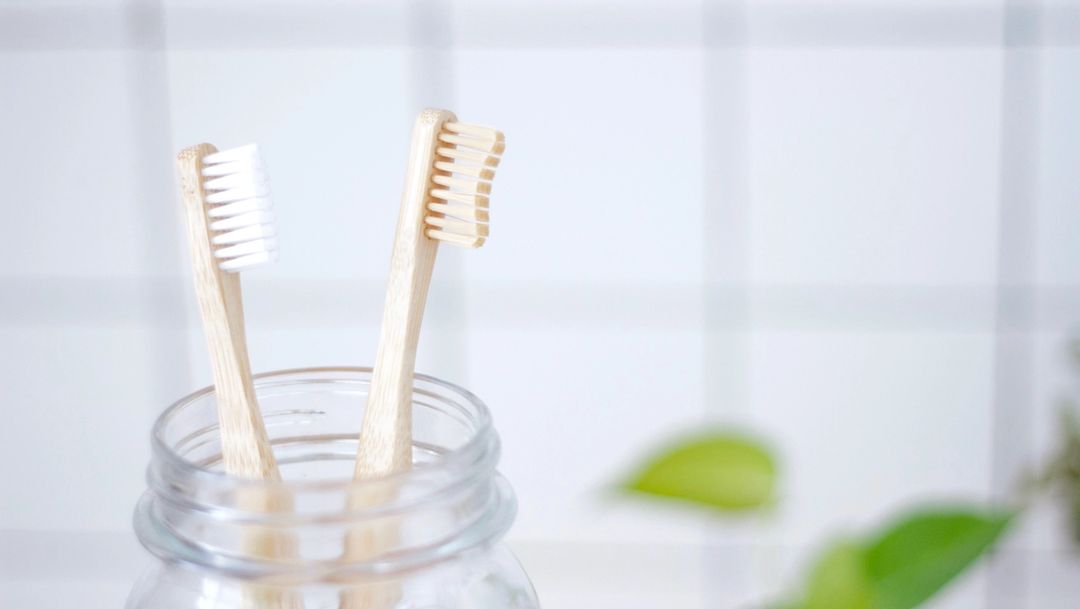Eco-Friendly Toothbrushes

October 30, 2019
10/29/2019
Written by: Natalie Henderson, Marketing @blueland
You know that plastic toothbrush you had as a kid? That’s still floating around on the planet somewhere. Brushing your teeth is an important part of your daily routine, but while your toothbrush might keep your teeth clean, it definitely isn’t keeping the planet clean. Plastic toothbrushes create a large amount of plastic waste that doesn’t break down over time. Instead, plastic from these toothbrushes usually ends up in landfills or in our oceans. Make the eco-friendly switch from a plastic toothbrush to a compostable toothbrush and keep your mouth and the planet healthy.
What Is Your Toothbrush Made Out Of?
Most commercially available toothbrushes are made from plastic, rubber and nylon. The handles are plastic and rubber to make them easy to grip and easy to dry. The bristles are made from nylon. While toothbrushes have been around for a very long time, plastic and nylon toothbrushes are relatively recent inventions. Before plastic and nylon, toothbrushes were made from natural ingredients. The first “toothbrushes” were chew sticks used as early as 3000 BCE. People would chew on certain types of sticks to clean debris off of their teeth, and they would naturally biodegrade after use. In the eighteenth century, we started to see toothbrushes that look just like the ones we use today. This early form of toothbrush was made from animal bone and boar bristles. Both materials would naturally biodegrade.
In the 1930’s nylon was created in the U.S. Nylon quickly became the most common material from which to make toothbrush bristles. Nylon and plastic toothbrushes started to be manufactured on a large scale. While this was great for oral hygiene, it had some unintended consequences for the environment. In general, plastic toothbrush handles can be recycled. However, to recycle the toothbrush you have to first remove the nylon bristles. To do so, we recommend using tweezers or pliers. Though toothbrushes can be recycled, they are usually thrown in the trash. Like other plastic items, toothbrushes take a long time to breakdown, and never break down completely. So, after you throw away your toothbrush what happens?
Does Your Toothbrush Get Recycled?
Toothbrushes are hard to recycle and are usually thrown away in the trash. Like other plastics, when they are thrown away they either go to landfills or oceans. On average, one person uses 300 toothbrushes in their lifetime. In the U.S. alone, 1 billion toothbrushes are thrown away every year. These toothbrushes end up in landfills or the ocean, where they can be harmful to our marine life. When they do break down, they break down into microplastics. Microplastics are tiny plastic pieces that marine animals often mistake for food. Microplastics are in 33% of the fish we eat and 95% of water that we drink. We do not want to create anymore microplastics, so it’s time to ditch the plastic toothbrush, but what should you use instead?
Plastic Toothbrush Alternatives
Eco-friendly toothbrushes are going back to basics. Toothbrushes made from natural materials such as bamboo are much more environmentally friendly and sustainable. Here are some of our favorite eco-friendly options.
1. Bamboo toothbrushes:
Toothbrush handles made from bamboo are an eco-friendlier option than plastic toothbrushes. Bamboo is a sustainable material that grows quickly with relatively few resources. Bamboo toothbrushes are typically biodegradable, but you have to check what the bristles are made from. Since there are few alternatives to nylon bristles, you will most likely still have to remove the bristles from the bamboo handle.
2. Boar bristle toothbrush:
Boar bristle toothbrushes are one of the only completely biodegradable toothbrush alternatives. Boar bristles can be composted and typically boar bristle brushes are made with a bamboo handle or other type of biodegradable handle. Boar bristle toothbrushes are made from an animal product, so they are not vegan-friendly.
3. Neem sticks:
Neem sticks are a vegan and environmentally friendly toothbrush alternative. To use a neem stick, you chew the bark until you have exposed the inside of the stick. This part resembles bristles, and can then be used like a typical toothbrush. Neem sticks are a very different form of brush than our typical toothbrushes, and they are not everyone’s cup of tea. But, they are the most sustainable option, so they are worth a try!
Whether you choose a bamboo toothbrush or a neem stick, making the swap from a plastic toothbrush to a more sustainable option can help cut down on a lot of single-use plastic. Help keep your teeth clean while keeping the planet clean!
Keep Reading
Refill is the New Recycle
The perfect way to start cutting out single use plastic from your home.











